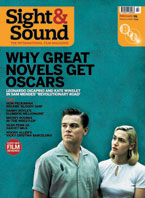Primary navigation


Tim Lucas on a controversial 1982 film now held by many to be director Samuel Fuller's last great American movie
White Dog
Samuel Fuller; USA 1982; Criterion/Region 1; Aspect Ratio 1.78:1; Features: 'Four-Legged Time Bomb' including interviews with co-screenwriter Curtis Hanson, producer Jon Davison and Fuller's widow Christa Lang-Fuller, illustrated print memoir by dog-trainer Karl Lewis Miller, photo gallery, booklet with essays by J. Hoberman and Armond White and Fuller's 1982 'interview' with canine star
White Dog opens, like Kieslowski's Three Colours: Red, with a young woman - Julie Sawyer, an actress (played by Kristy McNichol) - hitting a dog with her car and not fleeing the scene, her kind nature leading her from taking responsibility for her actions into a larger story of proactive human responsibility. The white German shepherd she has struck is discovered to be not just an attack dog, as initially suspected when it saves her from an attempted rape, but a 'white dog' - specifically trained by racist owners to attack and kill black people. While everyone in Julie's life, including her screenwriter boyfriend (Jameson Parker), encourages her to have the dog destroyed, she takes it to a Hollywood trained-animal compound for reconditioning. The principal owner, Carruthers (Burl Ives), refuses, but his black partner Keys (Paul Winfield) accepts the challenge, finding the killing of the dog analogous to admitting that racism cannot be unlearned, and promising to shoot the animal if he can't redirect its hateful impulses within five weeks.
Directed by Samuel Fuller, who co-scripted with Curtis Hanson, White Dog is compelling in several ways - as a study in good and evil, as a detective story involving animal psychology, as an acting tour de force from a robust and fully committed Winfield (who did all his own stunts), as a postscript to Fuller's career-long interest in race as a factor in human relationships (as found in Shock Corridor, The Crimson Kimono, Run of the Arrow) - but it falls short of its growing reputation as Fuller's last great American movie.
One begins to see how much more it could have been when one realises that McNichol - a then popular 19-year-old TV actress who looks four years younger - is playing Jean Seberg and Jameson Parker her writer/husband Romain Gary, whose 1970 non-fiction novella was the film's basis. To get the film made, Gary's bleak memoir, which touched on Seberg's connection to the Black Panthers, had to be updated and converted into what is to some degree an exploitation piece, and the influence of former New World Pictures producer Jon Davison is evident in such little grace notes as a street-cleaning truck crashing through a dress shop after its black driver is mauled by the white dog, and cameos by beloved B-movie actors Paul Bartel and Dick Miller. These are actually some of the picture's strengths.
Its weaknesses are best summarised by the shot that zooms into Keys' proprietary name on the sign of the animal compound, before dropping down to his first walk-on: nearly every scene is virtually subtitled with intent. The most famous sequence, in which a black man is savaged by the dog inside a church, climaxes with a much too deliberate tilt up to a stained-glass window depicting St Francis of Assisi surrounded by kindly animals; once is more than enough, but Fuller comes back for a second, more insistent look at the window, in case we missed it. The attack scenes are played for poetry and effect rather than impact and viciousness, with Ennio Morricone's monotonally tragic score lavished over slow-motion shots of menace and carnage that distance rather than involve the viewer.
But perhaps the greatest weakness is the casting of McNichol, who can't summon the depth required of her role and, frankly, isn't given much to portray. As 'Roland Gray', Parker has most of his dialogue looped, and Burl Ives, while well cast in terms of presence as head of the compound, delivers most of his lines with his back turned to the camera. (He does get the honour of delivering a full-out declaration of war against a poster of R2D2 - "That is the enemy!" - the symbol of George Lucas' juvenilisation of American cinema.) The film's most haunting scene - because it takes the subtle and disturbing path of showing race to be a difficult if not taboo issue even in loving interracial relationships - is when Julie goes to hospital to visit Molly (Lynne Moody), her black co-star in a theatre audition, and can't bring herself to admit that the attack on her friend was precipitated by the dog's training.
After a successful premiere in France, White Dog fell victim to damaging (and absurd) pre-release rumours that it was a racist picture rather than a movie about racism, and was abandoned by Paramount without a US theatrical release. Criterion's DVD marks its first ever availability on disc. The presentation is superlative, built around a new transfer that's so vivid and film-like it could scarcely be improved upon by Blu-ray. If not for some 'spoiler' references to the film's ending, the supporting Four-Legged Time Bomb featurette would work as an ideal introduction to the main course: it's a rousing tribute to Fuller in which Hanson, Lang-Fuller and especially Davison prove themselves spirited representatives for the cigar-chomping maverick. The background stories admit to factors such as imminent writers' and directors' strikes, which required unusual haste in scripting and planning, and Davison credits Michael Schlesinger (then of Paramount Repertory) for resurrecting the film in 1991 with a 35mm print prepared for special bookings.